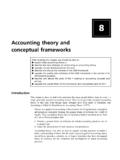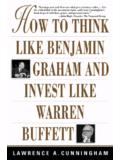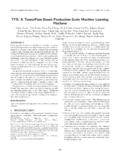Transcription of How to find the right support and resistance What works and
1 How to find the rightsupport andresistanceBy Joe DuffyFinding support and resistance for aday-trader can keep him alive in avolatile market. Here's one idea,implemented with others, to findthose target day-tradingsystems: what works andwhat doesn'tBy George PruittIf you want to develop a system,here are some ideas gleaned fromstudying top performing day-tradingsystems. If you would rather buy asystem, those that only trade theS&P 500 seem to do the 'edge'By Frank J. AlfonsoThe best advice for an off-floortrader who wants to day- trade is todevelop or buy a system that willforce him into action. Buying asystem may save you time, but youshould use the same rigorous rulesto test TDSequential tointraday chartsBy Tom DeMarkOriginally designed for dailyanalysis, Tom DeMark's TDSequential indicator also works forintraday analysis. It is especiallyeffective for targeting high- andlow-risk entry advantage ofthe big eventBy Mitchell HollandDay- trading takes more finesse thanmost techniques.
2 Here is a way totake advantage of market reports,etc. without being taken out beforethe market ready: How anoptions specialistprepares for themarket openingBy Jon NajarianWhen a professional options traderprepares for the day's market, helooks at much more than technicalindicators. Here's a personal accountof what it takes to be prepared forthe 's paradiseBy James T. HolterThere's more than just knowing how to day-trade. You mustknow where to day-trade. Good day-tradable markets havecertain attributes. Knowing these, and which markets have them,at least puts you in the right in a day's workBy Mark EtzkornWhy day-trade? It's a good way to control risk for one thing. Butit's also a unique game. We'll give you some ideas on how tomake the most of the advantages and avoid the you need for day-tradingspeedBy Darrell JobmanBefore you can put even stellar day- trading ideas to work, youmust have a way to get price data to you and your order to thefloor.
3 Here's what the prospective day-trader needs to set : Not what you thinkBy Mark D. CookFrom a 25-year veteran of day- trading , here are the rules forsucceeding in this most difficult of time overviewBy Jake BernsteinDay- trading 's time has come with the advent of intraday quotesand software availability. Still, some technical analysistranscends time. Here an old pro provides the strengths andweaknesses of applying those to to day- trading :Have your 'team' in placeBy Chris McGinnisMore important for the day-trader than others is to have theproper 'team' in place. You especially need a good floor brokerwho can execute your trades in a heartbeat. But, you must payhim 2001 Futures Magazine Art of Day- trading : Table of [5/14/2001 2:44:42 am]Special Online Offer:Day- trading Ideas & StrategiesIf you found some profitible ideas in the online special issue The Art ofDay- trading , you're sure to enjoy the even more comprehensive Day-TradingIdeas & special issue is now available as an electronic, fully viewable *.
4 Pdf fileexclusively to online readers of The Art of Day- trading at the special price of$ (regular price: $ ). Using Adobe's free Acrobat Reader (downloadfrom Adobe here), you can read, navigate and study the valuable strategies andinformation in this popular special issue right from your own computer!Here are just a few of the topics in Day- trading Ideas & Strategies:Successfully Scalping the S&P 500 by Linda Devil's in the Data by Bob 's Doom: Whipsaws & How to Avoid Them by Software Shootout by James T. much more!To order this electronic special issue for speedy e-mail delivery, just call ouroperators with your credit card information handy at (800) 972-9316, ext. 2001 Futures Magazine Art of Day- trading : Table of [5/14/2001 2:44:44 am] How to find the rightsupport and resistanceMy personal preference for day- trading and short-term trading is tobuy dips and sell components are needed to make this strategy work.
5 First, youhave to be trading in the direction that gives you the best chance ofsuccess. Second, you have to be able to identify potential support orresistance for that trading day. I'll discuss one technique from eachof these two components that make up my day- trading first step is to determine which way the market is likely to go today -- in other words,is the trend up, down or sideways?One method to determine the market trend involves a couple of old standby technicalindicators that are available on virtually any charting software: the Moving AverageConvergence Divergence (MACD) and the stochastic indicators. These oldies but goodiesreally can be useful if used in the proper at both the MACD and the Slow Stochastic on adaily chart to determine in which direction you want totrade the next day. For the MACD, I use a little longertime value for my inputs then the standard -- say, around a10-30-10 exponential moving average combination.
6 I alsouse a slow stochastic indicator with an input value ofsomewhere around 20 of these indicators should be displayed together under the price data. Look forsituations when both the MACD indicator and the stochastic indicator are on the same sideof the signal both are above their respective signal lines, then trade the buy side. If both are belowtheir respective signal lines, trade the sell side. Quite often you'll find the MACD and thestochastic indicators are on opposite sides of their respective signal lines. In theseinstances, avoid the accompanying charts show this simple combination eliminates a lot of noise from themarket and identifies those times when the market has the best chance to make a trendmove. Throw these indicators up on any chart together,and you will see this combination works infinitely betterthan either indicator you've determined the direction to trade, the nextstep is to find support if you want to buy or resistance ifyou want to sell.
7 There are several ways to do this, andmy usual strategy is to employ several methodologies tocome up with a confluence or a "keypoint" high-probability trading is one methodology that is being described for the first time. There is no neat namefor this indicator, so I'll just call it the 3x5 ATR. To construct it:1. Add up the true ranges for the last five days and divide by five. This is the Calculate a three-day simple moving average of the highs and a three-day simplemoving average of the To calculate the 3x5 ATR for potential resistance , add the 5 ATR to the three-day movingaverage of the lows. To calculate the 3x5 ATR for support , subtract the 5 ATR from thethree-day average of the important point is that this is not a total day- trading strategy. Look to combine othertechniques that identify potential support and resistance points. A good rule to live by is tolook for a confluence of support or resistance by integrating analysis techniques andintegrating time Duffy is a former trading contest champion and author of three books and videos onhis trading techniques.
8 A private trader, he contributes research and analysis to the"Professional Traders Advisory," a daily market letter specializing in stock indexes, bondsand selected special situations in the futures markets. E-mail: to contents pageCopyright 2000 Futures Magazine to find the right support and resistance [5/14/2001 2:44:48 am]The alignment of the MACD and stochastic indicators together shows you the market both indicators are below the signal line, as they were in early December for both the S&P500 Index and T-bonds, you should be a seller; if both are above the signal line, as they were inearly February, you should be a S&P 500 index futures/March T-bond [5/14/2001 2:44:53 am]By combining the five-day average true range with simple three-day moving averages of the highsand lows, you can create the 3x5 ATR indicator to find support and resistance areas that can beused in a day- trading strategy of buying on dips and selling on rallies.
9 The S&P charts above andthe above, left T-bond chart show examples of support lines using the 3x5 ATR; the above, rightT-bond chart illustrates a resistance line using the and resistence [5/14/2001 2:45:02 am] S&P day-tradingsystems: what works andwhat doesn'tOf all the day- trading systems I've tested over the years, 90% ofthem trade the S&P 500. This is the market of choice for mostday-traders because it affords enough potential to make it aworthwhile venture (see "Volatility heaven," below). By definition,day- trading means you exit at the end of the day, so your profitsmust at least cover your commissions and a key difference with the S&P systems I've tested is theirapproach to entering the market -- they have ranged from basic breakout systems tosystems based on the phases of the moon -- the exit signals usually fall into fourcategories: protective stop, profit target, trailing stop and, of course, market on of the systems use a combination of these the exit technique is as much or more important than the entry in day- trading theS&P 500, I'll demonstrate that different types of exits work with various types of the past eight years I've often been asked which exit technique is the best.
10 Theanswer is it depends on the system; there is no black or white answer. However, throughresearch, I've found the success of these exit techniques usually depends upon thefrequency of trades a system generates: More frequent trading systems need tighter exitswhereas less frequent trading systems need looser heavenTo demonstrate the success or failure of protective stops,profit targets and trailing stops, I've created two systemsand tested them over the past 11 systems use basically the same entry technique,except one trades about five times as much as the and sell signals are calculated by adding/subtractinga certain percentage of the 10-day-average range to yesterday's close. In addition, today'srange must be less than the 10-day-average range before a buy/sell signal can be only difference in the two systems is the percentage used to calculate the buy/sellsignals. System A uses 50% and System B uses 120%. These percentages were determinedby the frequency of trades I was trying to systems were tested using five-minute bar data and deducting $100 commission/slippage per trade.










